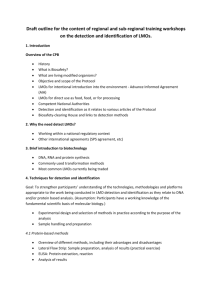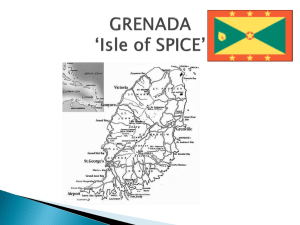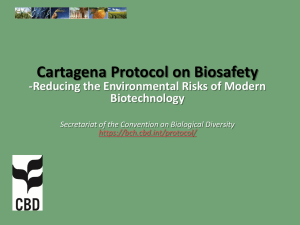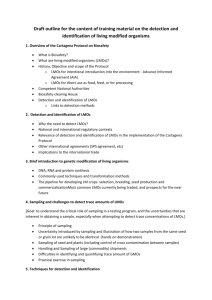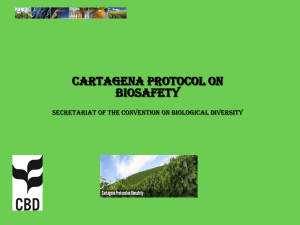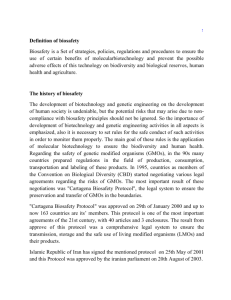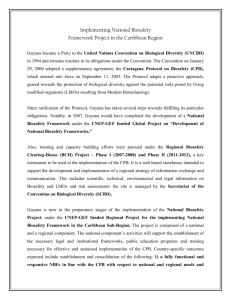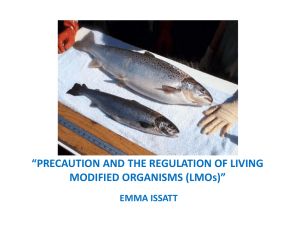English - Convention on Biological Diversity
advertisement
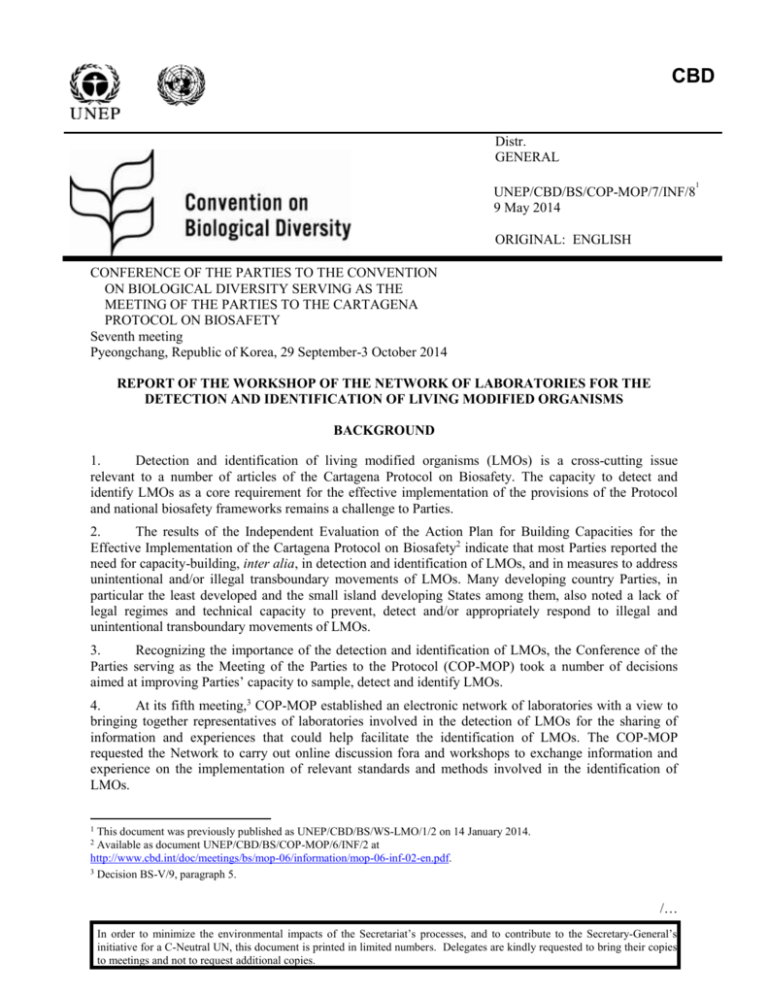
CBD Distr. GENERAL UNEP/CBD/BS/COP-MOP/7/INF/8 9 May 2014 ORIGINAL: ENGLISH CONFERENCE OF THE PARTIES TO THE CONVENTION ON BIOLOGICAL DIVERSITY SERVING AS THE MEETING OF THE PARTIES TO THE CARTAGENA PROTOCOL ON BIOSAFETY Seventh meeting Pyeongchang, Republic of Korea, 29 September-3 October 2014 REPORT OF THE WORKSHOP OF THE NETWORK OF LABORATORIES FOR THE DETECTION AND IDENTIFICATION OF LIVING MODIFIED ORGANISMS BACKGROUND 1. Detection and identification of living modified organisms (LMOs) is a cross-cutting issue relevant to a number of articles of the Cartagena Protocol on Biosafety. The capacity to detect and identify LMOs as a core requirement for the effective implementation of the provisions of the Protocol and national biosafety frameworks remains a challenge to Parties. 2. The results of the Independent Evaluation of the Action Plan for Building Capacities for the Effective Implementation of the Cartagena Protocol on Biosafety2 indicate that most Parties reported the need for capacity-building, inter alia, in detection and identification of LMOs, and in measures to address unintentional and/or illegal transboundary movements of LMOs. Many developing country Parties, in particular the least developed and the small island developing States among them, also noted a lack of legal regimes and technical capacity to prevent, detect and/or appropriately respond to illegal and unintentional transboundary movements of LMOs. 3. Recognizing the importance of the detection and identification of LMOs, the Conference of the Parties serving as the Meeting of the Parties to the Protocol (COP-MOP) took a number of decisions aimed at improving Parties’ capacity to sample, detect and identify LMOs. 4. At its fifth meeting,3 COP-MOP established an electronic network of laboratories with a view to bringing together representatives of laboratories involved in the detection of LMOs for the sharing of information and experiences that could help facilitate the identification of LMOs. The COP-MOP requested the Network to carry out online discussion fora and workshops to exchange information and experience on the implementation of relevant standards and methods involved in the identification of LMOs. 1 This document was previously published as UNEP/CBD/BS/WS-LMO/1/2 on 14 January 2014. Available as document UNEP/CBD/BS/COP-MOP/6/INF/2 at http://www.cbd.int/doc/meetings/bs/mop-06/information/mop-06-inf-02-en.pdf. 3 Decision BS-V/9, paragraph 5. 2 /… In order to minimize the environmental impacts of the Secretariat’s processes, and to contribute to the Secretary-General’s initiative for a C-Neutral UN, this document is printed in limited numbers. Delegates are kindly requested to bring their copies to meetings and not to request additional copies. 1 UNEP/CBD/BS/COP-MOP/7/INF/8 Page 2 5. The COP-MOP, at its fifth meeting, also adopted the Strategic Plan for the Cartagena Protocol on Biosafety to galvanize Parties towards the effective implementation of the Protocol during 2011-2020.4 The Strategic Plan under focal areas 1 and 2 sets out following specific operational objectives, outcomes and indicators to address the issue of LMO detection and identification: Operational objectives Outcomes Indicators Focal area 1 – Facilitating the establishment and further development of systems for the implementation of the Protocol 1.6 Handling, transport, packaging and identification To enable Parties to implement the requirements of the Protocol and COP-MOP decisions on identification and documentation requirements for living modified organisms 1.8 Transit, contained use, unintentional transboundary movements and emergency measures To develop tools and guidance that facilitate the implementation of the Protocol’s provisions on transit, contained use, unintentional transboundary movements and emergency measures Easy to use and reliable technical tools for the detection of unauthorized LMOs are developed and made available Number of Parties with access to tools that are capable of detecting unauthorized LMOs Guidance developed to assist Parties to detect and take measures to respond to unintentional releases of living modified organisms Percentage of Parties using the guidance to detect occurrence of unintentional releases of living modified organisms and being able to take appropriate response measures Focal area 2 – Capacity-building 2.3 Handling, transport, packaging and identification To develop capacity for handling, transport, packaging and identification of living modified organisms Personnel are trained and equipped for sampling, detection and identification of LMOs Percentage of Parties that have established or have reliable access to detection laboratories National and regional laboratories certified with the capacity to detect LMOs Number of certified laboratories in operation 4 Decision BS-V/16. /… UNEP/CBD/BS/COP-MOP/7/INF/8 Page 3 6. Further, at its sixth meeting, COP-MOP invited Parties and other Governments to (i) cooperate in building the capacity, transferring the technology and exchanging information necessary to detect and respond to occurrences resulting in a release that could lead to unintentional transboundary movement of an LMO that is likely to have significant adverse effects on the conservation and sustainable use of biological diversity, taking also into account risks to human health;5 and (ii) cooperate with and support developing country Parties and Parties with economies in transition to build capacity to implement the detection and identification requirements of paragraphs 2 (b) and 2 (c) of Article 18 of the Protocol and related decisions, including by facilitating the transfer of technology. 6 The COP-MOP also adopted the Framework and Action Plan for Capacity-Building for the Effective Implementation of the Cartagena Protocol on Biosafety and a results-based “Action Plan” containing, among other things, actions needed for achieving the outcome under focal area 2 in as outlined in the table above. 7. In response to the requests of COP-MOP regarding the detection and identification of LMOs, the Secretariat organized a series of discussions under the Network of Laboratories for the Detection and Identification of LMOs.7 Further to the online discussions and following a generous financial contribution from the Government of Japan, the “Workshop of the Network of Laboratories for the Detection and Identification of Living Modified Organisms” was held at the European Commission’s Joint Research Centre (JRC), Institute for Health and Consumer Protection in Ispra, Italy, from 25 to 27 November 2013. 8. The specific objectives of the workshop were to develop: (a) A detailed implementation strategy for the detection and identification of LMOs consisting of a plan of action to assist Parties in making progress toward the outcomes of the Strategic Plan as per paragraph 5 above; and (b) A set of recommendations identifying possible key players and specific activities to assist in the implementation of the plan of action in (a) above. 9. The workshop was attended by 24 participants from 22 Parties (Antigua and Barbuda, Belarus, Brazil, Democratic Republic of the Congo, El Salvador, European Union, Germany, Hungary, India, Japan, Jordan, Kenya, Lebanon, Liberia, Lithuania, Malaysia, Mexico, Norway, Republic of Moldova, Slovenia, South Africa and the former Yugoslav Republic of Macedonia) as well as four observers from organizations (Global Industry Coalition (GIC), GenØk - Centre for Biosafety, and International Seed Testing Association (ISTA)). The list of participants is available as annex I below. ITEM 1. OPENING OF THE WORKSHOP 10. The workshop was opened by the Director of the European Commission’s Joint Research Centre Institute for Health and Consumer Protection, Mr. Krzysztof Maruszewski, at 9.30 a.m. on Monday, 25 November 2013. 11. In his remarks Mr. Maruszewski welcomed the participants and the Secretariat, emphasizing the importance of effective biosafety frameworks and regulations along with efficient compliance systems to ensure safety in the use of LMOs as well as to improve consumer perception. He also explained the mandate and structure of the JRC and how its work contributes to the implementation of the biosafety regulations in the European Union. 12. Mr. Charles Gbedemah, on behalf of Mr. Braulio Dias, Executive Secretary of the Convention on Biological Diversity, also welcomed the participants to the workshop. He noted the importance of detection and identification of LMOs for the effective implementation of the Protocol. 5 Decision BS-VI/16, paragraph 3. Decision BS-VI/8, paragraph 4. 7 Available at http://bch.cbd.int/onlineconferences/portal_detection/discussions.shtml. 6 /… UNEP/CBD/BS/COP-MOP/7/INF/8 Page 4 ITEM 2. WORKSHOP OBJECTIVES AND EXPECTED OUTCOMES 13. After self-introductions by the participants, Mr. Gbedemah introduced the workshop objectives and expected outcomes, and invited participants to consider and adopt the provisional agenda circulated by the Secretariat as document UNEP/CBD/BS/WS-LMO/1/1. The agenda was adopted without amendments. ITEM 3. RELEVANT ISSUES AND RECENT DEVELOPMENTS UNDER THE CARTAGENA PROTOCOL ON BIOSAFETY 14. Under this agenda item, presentations were made by Mr. Gbedemah and Ms. Dina Abdelhakim of the Secretariat to provide an overview of the Protocol’s provisions and recent developments related to the detection and identification of LMOs, including: (a) Relevant articles of the Cartagena Protocol on Biosafety: Risk Assessment (Article 15), Risk Management (Article 16), Unintentional Transboundary Movements and Emergency Measures (Article 17), Handling, Transport, Packaging and Identification (Article 18), Information Sharing and the Biosafety Clearing-House (Article 20), and Illegal Transboundary Movements (Article 25); (b) Strategic Plan for the Cartagena Protocol on Biosafety for the period 2011-2020;8 and (c) Status of the capacity, at regional and national levels, to detect and identify LMOs. 15. A number of further presentations were made by participants on issues that are relevant to the detection and identification of LMOs, with a focus on the exchange of experience and challenges in detecting unauthorized and/or unintentionally released LMOs and gaps in current methodologies in order to establish a basis for discussions. Each presentation was followed by brief discussions and a short period of questions and answers. 16. The presentations9 covered the following topics: (a) South Africa; (b) Overview of methods for the detection and quantification of LMOs – Mr. Chris Viljoen, Status of capacity-building in LMO analysis – Ms. Maddalena Querci, European Union; (c) Quality system implementation in a GMO testing laboratory – Mr. Marco Mazzara, European Union; (d) Biosafety regulations in Mexico and the national network for the detection, identification, and quantification of genetically modified organisms – Ms. Natalhie Campos Reales Pineda, Mexico; (e) Detection of unauthorized LMOs and unintentional introductions into the environment – Mr. Bjørn Spilsberg, Norway; (f) Experience of development of detection methods for unapproved GM papaya – Ms. Ayako Yoshio, Japan; (g) (h) Shillito, GIC. 8 9 Cost efficient DNA-based GM diagnostics – Gurinder Randhawa, India; and Overview of available information for the detection and identification of LMOs – Ray Decision BS-V/16 http://bch.cbd.int/protocol/issues/cpb_stplan_txt.shtml. The presentations can be found at http://bch.cbd.int/onlineconferences/portal_art18/htpi_workshop.shtml. /… UNEP/CBD/BS/COP-MOP/7/INF/8 Page 5 17. Finally, each participant was invited to give a short presentation highlighting their experience and current activities in detection and identification of LMOs. ITEM 4. 4.1. SUBSTANTIVE ISSUES Development of an implementation strategy for the detection and identification of LMOs 18. Under this agenda item, activities took place with a view to developing an implementation strategy that will assist Parties in achieving the outcomes of the Strategic Plan that are relevant to the detection and identification of LMOs. 19. An initial brainstorming session took place in plenary aiming at establishing a common understanding of the three outcomes in paragraph 5 above. Taking into account that the two outcomes under focal area 1 (i.e., “Easy to use and reliable technical tools for the detection of unauthorized living modified organisms are developed and made available”; and “Guidance developed to assist Parties to detect and take measures to respond to unintentional releases of living modified organisms”) are complementary to one another, the outcomes were addressed together to facilitate the development of the implementation strategy. 20. Workshop participants were then invited to break out into three groups and consider a results-based implementation strategy, consisting of specific activities, main actors, results/outputs and time frame that, if put into practice, would assist Parties in achieving the outcomes of the Strategic Plan. The three break-out groups reported back and discussed, in plenary, the specific needs for technical tools and guidance for the detection of unauthorized LMOs and unintentional releases. 21. The workshop participants agreed that the technical tools and guidance needed by Parties to detect and identify unauthorized LMOs and unintentional releases are largely available. However, this body of knowledge is scattered and not easily accessible to Parties. Participants further agreed that the compilations of such technical tools and guidance would facilitate Parties’ access to these resources. They further discussed actions that could be taken to ensure that these resources are accessible to Parties in accordance to their needs. 22. On the basis of a synthesis prepared by the Secretariat and further discussions in plenary, the workshop participants developed a list of topics for which technical tools and guidance are to be compiled or developed, as appropriate. The list is available in annex II. 23. The participants of the workshop agreed that the development of some of these technical tools and guidance would require primarily a compilation of available resources. They further agreed that the Network of Laboratories for the Detection and Identification of LMOs could take the lead, in collaboration with the Secretariat, in compiling these resources mainly through online discussions and make them available through the Biosafety Clearing-House (BCH). 24. Taking into account the complexity of each of the topics, participants agreed to prioritize five topics for the compilation of technical tools and guidance prior to the seventh meeting of the COP-MOP. They also agreed that the remaining technical tools and guidance could be addressed after the seventh meeting of the COP-MOP, as appropriate. 25. The five prioritized topics, and respective moderators as selected by the group, are as follows: (a) Introduction and strategic umbrella (Moderators: Joachim Kreysa, Angela Lozan, Lilian Odongo, and Nisreen Al-Hmoud); (b) Overview of available detection methods, including validated methods (Moderators: Chris Viljoen, Sarah Agapito-Tenfen, and Gretta Abou-Sleymane); (c) Overview of available databases for methods and sequence information, and available screening matrixes (e.g., Waiblinger table) (Moderators: Bjørn Spilsberg, and Petra Heinze); /… UNEP/CBD/BS/COP-MOP/7/INF/8 Page 6 (d) Minimum performance criteria for sample handling, extraction, detection and identification methodology (Moderators: Natalhie Campos Reales Pineda, and Mojca Milavec); (e) Experience and case studies on detection and identification (Moderators: Gurinder Randhawa and Ayako Yoshio). 26. Ms. Maddalena Querci was elected as the rapporteur. 27. Participants further agreed on a tentative timeline for the main milestones in the way forward prior to the seventh meeting of the Parties, as follows: (a) Publication of the report of the workshop by 23 December 2013; (b) Drafting of text for introducing the online discussions on topics listed in subparagraphs 25 (b) through (e) above by 23 December 2013; (c) Drafting of the text on each topic to form the body of the technical tools and guidance between now and 28 February 2014; (d) Convening an online forum to compile information and resources to be included in the technical tools and guidance as hyperlinks from mid-January to 31 March 2014; (e) 31 July 2014. Publication of the technical tools and guidance on the five prioritized topics by 28. In addressing the third outcome of the Strategic Plan related to the detection and identification of LMOs, i.e., “Personnel are trained and equipped for sampling, detection and identification of LMOs” (under focal area 2, Capacity-building, operational objective 2.3), workshop participants were further invited to consider specific activities, main actors and time frame for building Parties’ capacity to sample, detect and identify LMOs. 29. Participants stressed the importance of theoretical and practical training of personnel involved in the sampling, detection and identification of LMOs. Participants further considered possible activities, including cost-effective online activities, which the Secretariat could organize, in coordination with relevant organizations to develop the capacity of Parties to sample, detect and identify LMOs, such as: (a) Strengthening regional networks of detection laboratories as a means to foster the exchange of knowledge and training opportunities at regional level; (b) Establishing strategies to promote the sharing of information regarding the availability of training opportunities in each region; (c) Delivering theoretical and practical training to personnel through online and face-to-face meetings/workshops; (d) Setting up an online communication platform in the form of an ongoing information sharing forum where participants can pose questions and receive answers from other members of the forum; and (e) Making training course manuals, educational DVDs and other resources available through the Biosafety Clearing-House. 30. Participants agreed that the specific activities and time frame for capacity-building on sampling, detection and identification of LMOs would be discussed, as appropriate, pending relevant decisions of the COP-MOP at its seventh meeting. 4.2. Recommendations regarding the detection and identification of LMOs 31. Under this agenda item, the chair invited the workshop participants to propose recommendations, including future actions to facilitate the detection and identification of LMOs, for consideration by the Conference of the Parties serving as the meeting of the Parties to the Protocol at its seventh meeting. /… UNEP/CBD/BS/COP-MOP/7/INF/8 Page 7 32. Working on the basis of the implementation strategy developed under agenda item 4.1, participants were invited to propose recommendations that identify specific activities through which the Secretariat and other relevant organizations can assist Parties in operationalizing the implementation strategy. 33. With a view to assisting the implementation of the plan of action beyond 2014, the participants of the workshop agreed on the following recommendations that the Parties may wish to consider at their seventh meeting: (a) Encourage Parties, with a view to facilitating the detection and identification of LMOs, to require LMO developers to make available, as appropriate, the sequences of transgenes, vectors and flanking regions of LMOs at the time of submission of an LMO application, and to provide the appropriate control samples in the event that an LMO is approved; (b) Invite Parties and other Governments to provide information regarding their capacity and needs in the detection and identification of LMOs, including a list of laboratories and their specific activities; (c) Establish an informal advisory committee to advise the Executive Secretary on matters relevant to the network on detection and identification of LMOs; (d) Urge Parties, with a view to facilitating the detection and identification of LMOs, to meet their obligations under Articles 17 and 25 and make available to the BCH information concerning cases of unintentional and illegal transboundary movements of LMOs; (e) Urge Parties to establish a rapid alert system at national and/or (sub)regional levels in cases where unauthorized LMOs and unintentionally released LMOs are detected; (f) Encourage Parties, with a view to facilitating the identification of LMOs unintentionally introduced into the environment, to submit to the BCH information on LMOs undergoing field trials; (g) Request the Executive Secretary to: (i) Improve the accessibility and availability in the BCH of information related to appropriate control samples, including certified reference materials and other reference materials, validated methods and protocols for LMO detection, including those protocols with limits of detection (LOD) and limits of quantification (LOQ); (ii) Explore the possibility, with LMO developers, of including the DNA sequence information of transgenes, vectors and flanking regions, as appropriate, in the LMO records available through the BCH; (iii) Convene a meeting of the informal advisory committee referred to in paragraph 33 (c) above in early 2015; (iv) Organize an ongoing online discussion through the Network of Laboratories where questions and answers can be posted pertaining to the detection and identification of LMOs; and (v) Organize, in cooperation with relevant organizations, subject to the availability of funds, capacity-building activities such as online training and face-to-face meeting/workshops in the fields of sampling, detection and identification of LMOs. ITEM 5. OTHER MATTERS 34. Participants expressed their gratitude to the JRC for hosting workshop as well as to the Secretariat for organizing it. /… UNEP/CBD/BS/COP-MOP/7/INF/8 Page 8 ITEM 6. ADOPTION OF THE REPORT OF THE WORKSHOP 35. A draft report was circulated online among the workshop participants for their comments for a period of one week. The Secretariat incorporated the necessary amendments into the final version of the report. ITEM 7. 36. CLOSURE OF THE WORKSHOP The workshop was closed at 4.15 p.m. on Wednesday, 27 November 2013. /… UNEP/CBD/BS/COP-MOP/7/INF/8 Page 9 Annex I LIST OF PARTICIPANTS OF THE WORKSHOP OF THE NETWORK OF LABORATORIES FOR THE DETECTION AND IDENTIFICATION OF LIVING MODIFIED ORGANISMS PARTIES Antigua and Barbuda 1. Mr. Linroy Christian Manager Fisheries Division Laboratory Environment Division Lower North Street St. John’s Antigua and Barbuda Tel.: +2687648338 Fax: +2684621372 E-Mail: fdlantigua@gmail.com Belarus 2. Ms. Galina Mozgova Senior Research Scientist Laboratory of Plant Genetics and Cell Engineering Institute of Genetics and Cytology, National Academy of Sciences of Belarus 27 Akademicheskaya Street Minsk 220072 Belarus Tel.: +375172949182 E-Mail: g.mozgova@igc.bas-net.by Brazil 3. Ms. Sarah Agapito-Tenfen Researcher Crop Science Department Universidade Federal de Santa Catarina Rod. Admar Gonzaga 1346 Itacorubi Florianopolis 88034-000 Brazil Tel.: +55 48 37215336 E-Mail: sarahagro@gmail.com Democratic Republic of the Congo 4. Mr. Freddy Bulubulu Otono Chercheur Departement de Biotechnologie et Biologie moleculaire Centre Regional d'Etudes Nucleaires de Kinshasa Commissariat General a l'Energie Atomique Av. Yumbu N°14, Binza/UPN, Commune de Ngaliema Kinshasa 868 Tel.: +243896562239 E-Mail: freddy.bulubulu@upn.ac.cd; freddybbl@yahoo.fr El Salvador 5. Mr. Jeremias Ezequiel Yanes Técnico en Biotecnologia - Punto Focal BCH Gabinete Técnico Ministerio de Medio Ambiente y Recursos Naturales Km 5½ Carretera a Santa Tecla Calle y Colonia las Mercedes (Instalaciones del ISTA) San Salvador El Salvador Tel.: +503 2132 9462 Fax: +503 2132 6231 E-Mail: jeritosv@yahoo.com, jeremiasyanes@marn.gob.sv Web: http://www.marn.gob.sv European Union 6. Mr. Joachim Kreysa European Commission Joint Research Centre Via Enrico Fermi 2749 21027 Ispra (Italy) Tel: +39 0332 786735 fax: +39 0332 786159 E-mail: Joachim.Kreysa@ec.europa.eu /… UNEP/CBD/BS/COP-MOP/7/INF/8 Page 10 7. Ms. Maddalena Querci European Commission Joint Research Centre via Enrico Fermi 2749 21027 Ispra (Italy) Tel: +39 0332 789308 fax: +39 0332 786159 E-mail: maddalena.querci@ec.europa.eu 8. Mr. Marco Mazzara European Commission Joint Research Centre Via E. Fermi 2749 21027 Ispra (Italy) Tel: +39 0332 78 5773 fax: +39 0332 786159 E-mail: marco.mazzara@jrc.ec.europa.eu Germany 9. Ms. Petra Heinze Federal Office of Consumer Protection and Food Safety Mauerstrasse 39-42 Berlin D-10117 Germany Tel.: +49 30 18444 40512 Fax: +49-30-18444-40099 E-Mail: petra.heinze@bvl.bund.de New Dehli 110 012 India Tel.: 011-25849459 E-Mail: gurinder.randhawa@rediffmail.com Japan 12. Ms. Ayako Yoshio Deputy Director Agricultural Product Safety Division Ministry of Agriculture, Forestry and Fisheries 1-2-1 Kasumigaseki, Chiyoda-ku Tokyo 100-8950 Japan Tel.: +81367442102 Fax: +81335808592 E-Mail: ayako_yoshio@nm.maff.go.jp Jordan 13. Ms. Nisreen Al-Hmoud Head Biosafety Unit Royal scientific Society Ahmad Tarawneh Street Amman 11941 Jordan Tel.: 0096265344701 Fax: 0096265340373 E-Mail: nisreen.hmoud@rss.jo Kenya Hungary 10. Mr. Boldizsar Vajda Head GMO Laboratory National Institute of Food Hygiene and Nutrition Mester u.81. Budapest H-1095 Hungary Tel.: 36-1 456-3010/112 E-Mail: drvajdab@gmail.com India 11. Ms. Gurinder Randhawa Principal Scientist, National Research Centre on DNA Fingerprinting National Bureau of Plant Genetic Resources Pusa Campus 14. Ms. Lilian Okiro National Biosafety Authority Egerton University Egrton - Njoro Nairobi 20115 Kenya Tel.: 254-051-2217891 E-Mail: lilyokiro@gmail.com Lebanon 15. Ms. Gretta Abou-Sleymane GMO testing Laboratory Department of Laboratory Science and Technology Faculty of Health Sciences AUST Alfred Naccash Avenue Ashrafieh 1100-2130 /… UNEP/CBD/BS/COP-MOP/7/INF/8 Page 11 Lebanon E-Mail: gretta.abousleymane@gmail.com Tel.: 009611218716--Ext 277 Mexico Tel.: +52 55 5575 6878 Ext 40 Fax: +52 55 5575 7618 Ext 30 E-Mail: ncampos@conacyt.mx Liberia Norway 16. Mr. Gulu Gwesa Laboratory Manager Microbiology National Standards Laboratory of Liberia Lynch Street Monrovia Liberia Tel.: +23188676155 E-Mail: ulug530@yahoo.com 20. Mr. Bjorn Spilsberg Scientist Norwegian Veterinary Institute Ullevaalsveien 68 Oslo 0454 Norway Tel.: +47 23216259 E-Mail: bjorn.spilsberg@vetinst.no Lithuania Republic of Moldova 17. Mr. Vaclovas Jurgelevicius Head of Department Nfvrai Molecular Biology and GMO Department National Food and Veterinary Risk Assessment Institute Kairiukscio-10 Vilnius 08409 Lithuania Tel.: +37052780459 Fax: +37052780471 E-Mail: vjurgelevicius@vet.lt 21. Ms. Angela Lozan Head of the Biosafety Office Ministry of Environment Str. Mitropolit Doseftei 156A, 305 Chisinau MD 2004 Republic of Moldova Tel.: +373 22 22 68 74 Fax: +373 22 22 68 74 E-Mail: angelalozan@yahoo.com Malaysia 18. Ms. Aniqa Akhtar Binti Abdullah Scientific Officer, GMO Unit Department of Chemistry, Malaysia Jalan Sultan, 46661 Petaling Jaya Selangor Darul Ehsan Malaysia Tel.: +60379853000 ext 3190 Fax: +60379556764 E-Mail: aniqa@kimia.gov.my, aniqaabdullah@gmail.com Mexico 19. Ms. Natalhie Beatriz Campos Reales Executive Director, Policy and Regulatory Affairs, CIBOGEM San Borja 938, Del Valle, Benito Juárez México D.F. 03100 Slovenia 22. Ms. Mojca Milavec Deputy Head of Quality System and GMOs Detection Department of Biotechnology and Systems Biology National Institute of Biology Vecna Pot 111 Ljubljana 1000 Slovenia E-Mail: mojca.milavec@nib.si South Africa 23. Mr. Chris Viljoen GMO Testing Facility, Department of Hematology & Cell Biology, Health Sciences University of the Free State Nelson Mandel Ave Bloemfontein 9300 /… UNEP/CBD/BS/COP-MOP/7/INF/8 Page 12 South Africa Tel.: +27 51 405 3656 Fax: +27 51 444 1036 E-Mail: viljoencd.md@ufs.ac.za The former Yugoslav Republic of Macedonia E-Mail: emilija@manu.edu.mk Fax: +3892115434 The former Yugoslav Republic of Macedonia 24. Ms. Emilija Shukarova Stefanovska Research Center for Genetic Engineering and Biotechnology Macedonian Academy of Sciences and Arts, RCGEB Skopje 1000 ORGANIZATIONS GenØk - Centre for Biosafety International Seed Testing Association 25. Ms. Lise Nordgard Scientist/Advisory Manager GenØk - Centre for Biosafety Science Park, PO 6418 Tromso Norway E-Mail: lise.nordgaard@genok.no Web: http://www.genok.org 27. Ms. Rita Zecchinelli Head, Italian Seed Testing Laboratory International Seed Testing Association CRA-SCS Laboratorio Via Emilia km 307 Tavazzano LO 26838 Italy Tel.: +39 0371 761919 Fax: +39 0371 760812 E-Mail: rita.zecchinelli@entecra.it Web: http://www.ense.it/ 26. Mr. Odd-Gunnar Wikmark Scientist/Program Coordinator GenØk - Centre for Biosafety Science Park, PO 6418 Tromso Norway E-Mail: odd-gunnar.wikmark@uit.no Web: http://www.genok.org Global Industry Coalition 28. Mr. Raymond Shillito Manager, Technical Coordination Seed & Trait Safety Bayer CropScience LP 407 Davis Drive Morrisville NC 27560 United States of America Tel.: +1 9195495684 E-Mail: ray.shillito@bayer.com /… UNEP/CBD/BS/COP-MOP/7/INF/8 Page 13 SECRETARIAT OF THE CONVENTION ON BIOLOGICAL DIVERSITY 29. Mr. Charles Gbedemah Senior Programme Officer Biosafety Division Secretariat of the Convention on Biological Diversity 413 St. Jacques Street, Suite 800 Montreal, QC, H2Y 1N9 Canada Tel.: +1 514 287 7032 Fax: +1 514 288 6588 E-Mail: charles.gbedemah@cbd.int 31. Ms. Manoela Miranda Environmental Affairs Officer Biosafety Division Secretariat of the Convention on Biological Diversity 413 St. Jacques Street, Suite 800 Montreal, QC, H2Y 1N9 Canada Tel.: +1 514 287 8703 Fax: +1 514 288 6588 E-Mail: manoela.miranda@cbd.int 30. Ms. Dina Abdelhakim Programme Assistant Biosafety Division Secretariat of the Convention on Biological Diversity 413 St. Jacques Street, Suite 800 Montreal, QC, H2Y 1N9 Canada Tel.: +1 514 764 6355 Fax: +1 514 288 6588 E-Mail: dina.abdelhakim@cbd.int /… UNEP/CBD/BS/COP-MOP/7/INF/8 Page 14 Annex II TECHNICAL TOOLS AND GUIDANCE TO ASSIST PARTIES IN THE DETECTION AND IDENTIFICATION OF LMOs Technical tools and guidance to be compiled prior to the seventh meeting of the COP-MOP: Introduction and strategic umbrella (Moderators: Joachim Kreysa, Angela Lozan, Lilian Odongo, and Nisreen Al-Hmoud); Overview of available detection methods, including validated methods (Moderators: Chris Viljoen, Sarah Agapito-Tenfen, and Gretta Abou-Sleymane); Overview of available databases for methods and sequence information, and available screening matrixes (e.g., Waiblinger table) (Moderators: Bjørn Spilsberg, and Petra Heinze); Minimum performance criteria for sample handling, extraction, detection and identification methodology (Moderators: Natalhie Campos Reales Pineda, and Mojca Milavec); Experience and case studies on detection and identification (Moderators: Gurinder Randhawa and Ayako Yoshio). Technical tools and guidance to be compiled after the seventh meeting of the COP-MOP: Topics pertaining to laboratory testing and analysis: Criteria for the selection of detection methods based on a Party’s national needs (including decision trees or checklists of possible strategies at different levels of detection requirements, i.e., presence, identification or quantification); Minimum requirements for detection laboratories according to their attributions, level of responsibility, handling of samples (quality system and proficiency testing); Access and availability of reliable reference materials; Selecting laboratories and assessing their competences; Steps to be taken for screening and/or identification (including the screening of landraces); How to interpret the results from matrix screening. Topics pertaining to setting up supporting systems (“pre-detection”): Setting up sampling strategies; Setting up a monitoring system (how to monitor for unauthorized LMOs, how to establish a surveillance programme for unauthorized LMOs including landraces); Setting up an inspection system; How to implement national enforcement; Setting up a rapid alert system among laboratories within a region/network. -----
